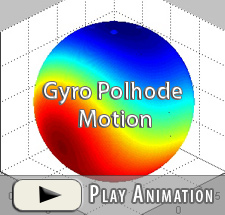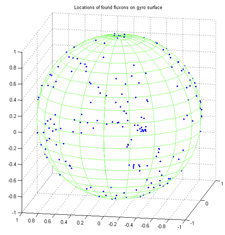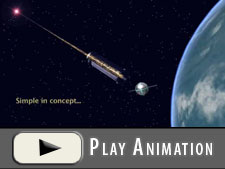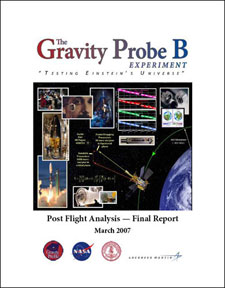MISSION UPDATE — SEPTEMBER 2007
PROGRAM STATUS
On 14 April 2007, at the American Physical Society (APS) meeting in Jacksonville, FL, we announced preliminary results of the GP-B experiment. In our June 2007 mission update, we provided a comprehensive overview of these results, including an in-depth discussion of two surprises in the data:
- A time variation in the polhode motion of the gyroscopes, which creates complications in the gyro scale factor calibrations (conversion of electrical signals to angles).
- Much larger than expected classical misalignment torques on the gyroscopes, attributable to “patch effect” (contact potential difference) interactions between the gyro rotors and their housings.
We also reported on the two methods being used to process the data—“geometric” and “algebraic,” including a refinement of the former, known as the “integral geometric” method—and we emphasized the process of mapping the profiles of trapped magnetic flux in the gyro rotors as a means for improving scale factor determination. In the last three and one half months, we have made significant progress in understanding and addressing both surprises, as well as combining the insights generated by both the geometric and algebraic methodologies towards a final result.
For example, the trapped flux mapping has now been completed for all four gyroscopes and results processed for each throughout the year. One very remarkable result is that we have succeeded in improving by a factor of ~500 the determination of the polhode phase and angle for each gyroscope throughout the duration of the experiment. In particular, the polhode motion for each gyro is now “phase-locked” and known to 0.1 radian (6 degrees) over the course of the experimental year.
As a result, a previous discrepancy between the scale factor calibration computed by the geometric and algebraic methods has been completely eliminated, and these two scale factor determinations are now in full agreement, within the current limits of measurement.
Furthermore, the improved knowledge of the polhode phase has laid the foundation for greatly improved determinations of the patch-effect torques. One of the intriguing puzzles at an earlier stage of the analysis was that the clocking of the gyroscope housings with respect to the rolling spacecraft frame appeared to vary with time, and from gyro to gyro, in a manifestly unphysical way. In other words, the rolling spacecraft is like a flywheel, and the gyro readout planes are very stably locked to it, so there cannot be any physical variation…yet, such variation appeared to be present in the data. Fortunately, the improved polhode phase determinations have effectively eliminated this apparent variation. Moreover, this modeling and estimation of the misalignment torque coefficient, which constitutes the main disturbance of gyro motion, has now been improved by a factor of five.
We are now proceeding with a detailed incorporation of the new results and a corresponding derivation of improved relativity results for review with our Science Advisory Committee (SAC) and with NASA in preparation for our 17th SAC meeting, which is scheduled here at Stanford on the 2nd of November.
THE GP-B DATA ARCHIVE AT THE NSSDC
Early this past July, we finished delivering an archive of raw GP-B data to the National Space Science Data Center (NSSDC) at the Goddard Space Flight Center in Greenbelt, MD. Since that time, the staff at the NSSDC has been processing and integrating the GP-B data into the NSSDC data archives.
- Click Here to view the GP-B data catalog record at the NSSDC, showing the current status of the GP-B data archive.
The data we recently sent to the NSSDC is classified as "Level 2 Science Instrument Source Data." This means that the data has been lightly processed. In other words, the individual data elements have been separated out from the compressed format in which the data was telemetered back to Earth, and they have been tagged and entered into a database.
You can learn more about how the GP-B data was collected, stored, and processed from two past GP-B updates on our Web site:
- The 14 January 2005 update describes the data collection and telemetering process.
- The 22 July 2005 update describes the data reduction and data analysis process.
A note regarding the Level 2 data currently at the NSSDC: Any results about gyro orientation history (and what it may say about relativity) need to be subsequently processed to calibrate the instrument, remove the effects of vehicle dynamics, aberration, guide star proper motion, small classical torques, and other systematic effects to ultimately make a measurement of general relativity.
In December, we are planning to make our final announcement of the results of GP-B. At that time, we will provide details on the subsequent Level 3 processing of the data that we have been working on for the past two years, including the measurements of general relativity that we have seen with this system. We will also be providing a GP-B Data Dictionary--kind of a Rosetta Stone that will enable people who are interested to understand what the various data elements are and how they are inter-related.
Without the data dictionary, the Level 2 raw data is not particularly useful. In December, when the data dictionary and the Level 3 processed data are added to the archive, it will be possible for people outside GP-B to perform further analysis on the data.
GP-B POST-FLIGHT ANALYSIS--FINAL REPORT TO NASA
Among the many projects we have been working on as the GP-B program approaches completion is our final Post Flight Analysis report to NASA. We began compiling some sections of this 616-page document while the GP-B experiment was still in progress. However, it has taken two more years to complete the final edits and prepare this report for public distribution.
Ultimately, this report will be assigned an official NASA document number and entered into the NASA Technical Reports server at the NASA Center for AeroSpace Information (CASI). In the meantime, we have posted the full report on our GP-B Web server in Adobe Acrobat PDF format for public viewing/downloading.
There are two versions of the report on the server:
- A highly-compressed, 12 MB screen viewable version. (Note: You can print pages from this version, but they will have very low-quality images.)
- A moderately-compressed, 29 MB printable version. (Note: Pages from this version will print acceptably on an ink jet or laser printer.)
USAFA USE OF THE GP-B SPACECRAFT
With the conclusion of the science data gathering phase of the GP-B mission at the end of September 2005, we began searching for other institutions and/or experiments that might wish to make use of the GP-B spacecraft. With the exception of the depleted superfluid helium needed to maintain the cryogenic environment required to run the GP-P relativity experiment, everything else on the satellite was working fine, and the satellite was expected to remain functional for at least 8 more years. The alternative, for which we began preparing in 2006, was to turn off and hibernate the satellite, essentially making it another piece of “space junk” until it de-orbited some 30 years from now.
Fortunately, former GP-B program manager Gaylord Green, with the help of former astronaut Fred Gregory (who was also a classmate of Green's at the U.S. Air Force Academy), initiated discussions with the Academy (USAFA) on converting GP-B into a platform for training space operations cadets and, with operable GPS receivers, star trackers and several other scientific apparatus, as a source of experiments for several departments at the USAFA.
In the summer of 2006, two cadet teams visited Stanford University to investigate joint SU/USAFA vehicle operations. During that time, Stanford provided detailed training in GP-B operations. Options for vehicle commanding and stand-alone USAFA capability were also investigated. The teams briefed members of the Astronautics and Physics Department, and the Center for Space and Defense Studies upon their return where the decision was made to proceed with the program. Through an OSD grant to the Center for Space and Defense Policy, USAFA continued to pursue GPB for use in Physics experimentation and as an operational asset to train cadets.
Note: We chronicled our joint activities with the USAFA in our monthly GP-B mission updates from June 2006 through February 2007, which you can read in our online archive of GP-B updates.
A Memorandum of Agreement between the USAFA and NASA, which enables the Academy to operate the GP-B spacecraft and use the NASA IONet, was signed in January 2007. Equipment for the first USAFA GP-B Mission Operations Center (MOC) was delivered from Stanford in October 2006. The equipment was successfully integrated into the IONet in February. On 7 May 2007, THE USAFA GP-B MOC successfully sent commands to and received data from the GP-B satellite through a NASA Tracking and Data Relay Satellite System (TDRSS) satellite for the first time. A summer Space 251 program allowed over 250 Academy and ROTC cadets to contact the satellite during status of health passes meeting requirements to wear basic cadet space wings.
Follow on programs for this semester include training cadets in using NASA's scheduling program for satellite passes, learning how to do ephemeris updates, changing the charging profile on the batteries to ensure operation for the next 8 years, and meeting a NASA safety requirement to vent the helium still on board that was used to spin up the gyroscopes. Physics and engineering possibilities include experiments using the star trackers, the GPS receivers on board, and the proton counters. Some of these experiments may tie in with data from the USAFA's own FalconSat-3 studies to provide confirmation of plasma bubble data from this experiment.
Comments or questions regarding the future use of Gravity Probe B can be directed to Steven Waiss, the USAFA Program Manager for GPB.
LINKS TO OTHER GP-B TOPICS
- GP-B Frequently Asked Questions (FAQ)
- Track the satellite in the sky
- Build a paper model of the GP-B Spacecraft
- Our mailing list—receive GP-B status updates via email
- View a Flash video of Professor Everitt's 18 May 2006 lecture on GP-B
Note: Both audio-only and video versions of this lecture are also available on the Stanford on iTUNES U Web site. This Web page automatically launches the Apple iTunes program on both Macintosh and Windows computers, with a special Stanford on iTunes U "music store," containing free downloads of Stanford lectures, performances, and events. Francis Everitt's "Testing Einstein in Space" lecture is located in the Science & Technology—Engineering section. People with audio-only iPods can download the version under the Audio tab; people with 5th generation (video) iPods can download the version under the Video tab.
Photos ,Drawings, and Graphics: The photo of Francis Everitt giving his plenary talk at the APS meeting was taken by APS Media Relations Manager, James Riordon. The graphs of trapped flux on gyro #1 and the comparative polhode phase graphs were created by the GP-B science team. The NSSDC logo is courtesy of NASA. The facsimile image of the GP-B PFA Report cover was created by GP-B Public Affairs Coordinator, Bob Kahn.The photos from the USAFA were taken by Steven Waiss, USAFA Program Manager for GP-B. Click on the thumbnails of any photo or graphic to view these images at full size.
Previous Update | Index of Updates










